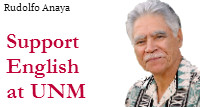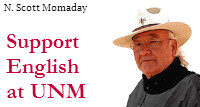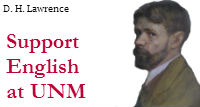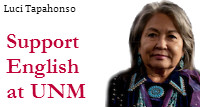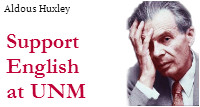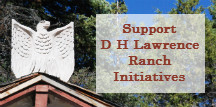Spring 2015 Course Descriptions
511.011: French Cinema
W 1600-1830
Rajeshwari Vallury, rvallury@unm.edu
516.001: Biography
M 1900-2130
David Dunaway, dunaway@unm.edu
This course explores how lives are told. By reading biographies and autobiographies of three major American authors (Twain, Kerouac, and Angelou), we compare narrative strategies to document a person's life. Using techniques of oral reminiscence, journal writing, literary recollection, and cultural research, students write a chapter of a biography or autobiography. (Post-Graduates write both.) This class will help students write and criticize biography and autobiography. Class work and reading emphasize both writing and literary history toward a clear end: the composition of a chapter with notes. Students contrast biographies and autobiographies to compare organization, stylistics, narrative strategy, and research. Our semester is divided into three parts: methodology and organization, study of specific lives, and class presentations. Class discussion will be both theoretical and practical, based on the instructor's experience as a biographer. The course fulfills advanced requirements in our Writing (creative non-fiction) and Literature (American) programs. Those planning biographical research as part of a thesis or dissertation are encouraged to enroll. Texts: Autobiography of Mark Twain, Charles Neider, ed.; Mr. Clemens and Mark Twain, Justin Kaplan; Kerouac, Ann Charters; On The Road, Jack Kerouac, I Know Why the Caged Bird Sings, Maya Angelou, How Can I Keep From Singing: Pete Seeger, David Dunaway.
520.001: Blue Mesa Review
MW 1400-1450; F 1500-1700
Emily Rapp, erapp@unm.edu
521.080: Creative Writing Workshop: Prose Fiction
Arranged
Dan Mueller, dmueller@unm.edu
522.001: Poetry Writing Workshop
R 1600-1830
Luci Tapahonso , Tapahons@unm.edu
This poetry workshop examines poetry through several lenses: your poetry as the main focus, careful critical responses to your peers' work as well as close studies of several contemporary American poets. You will write in open and fixed forms, and complete a portfolio of 15 poems during the semester. The course ends with a public reading by the class. Attendance and participation are critical in this course.
522.080: Creative Writing Workshop: Poetry
Arranged
Dan Mueller, dmueller@unm.edu
523.001: Creative Writing Workshop: Creative Nonfiction
1600-1830
Emily Rapp, erapp@unm.edu
523.080: Creative Writing Workshop: Creative Nonfiction
Arranged
Dan Mueller, dmueller@unm.edu
538.001: Writing Theory for Teachers
M 1600-1830
Todd Ruecker, truecker@unm.edu
Although a relatively young discipline, composition studies has a rich history with many areas of inquiry that influence the work we do as teachers of writing. In this course, we will explore these many areas by going to the research directly: reading and discussing articles published in various composition journals over the last several decades. We will explore theories of audience, genre, process, collaboration, second language acquisition, multimodal composition, among others. By the end of the course, students should emerge with a broad understanding of various theories circulating in composition and have the understanding necessary to pursue further work in a particular area. Class work will include weekly readings (typically 4-5 articles) and responses, a synthesis of work on a particular topic, and a final paper exploring a particular theory in depth.
539.001: Teaching Professional Writing
TR 1400-1515
Joseph Bartolotta, jbartolotta@unm.edu
Professional writing today is about far more than just composing clean technical descriptions and instruction sets. It is about sharing knowledge in a user-centered approach that delivers important information to people who need it most. This course prepares teachers to instruct courses such as ENGL 219 by establishing a sound theoretical and practical foundation to teaching technical and professional communication. This course will also help teachers develop professional teaching portfolios and address concerns that rise in the technical writing classroom. Students will walk out of this course with a syllabus and assignments ready to use in a technical and professional writing course. This course will also explore issues pertaining to social justice and community-engaged scholarship in professional communication, topics related to writing across the curriculum and writing in the disciplines, and the role of multimedia design in the delivery and dissemination of technical information. Please join us for an exciting semester!
ENGL 540.001: Language & Diversity
W 1600-1830
Michelle Kells, mkells@unm.edu
ENGL 440/540 will provide intensive study in language and literacy for teachers of college writing (as well as K-12). This course will bring three intellectual operating spaces into conversation: Sociolinguistics, Composition Studies, and Second-Language Literacy Education. The aim of this course is to guide the examination of current theoretical and applied approaches to teaching ethnolinguistically-diverse populations. Selected readings will center on the nature of human language, the processes of discourse acquisition, and the multiple dimensions of communicative competence. Special focus will be given to the teaching of Composition informed by sociolinguistic theory and research. We will attend to issues of: ethnolinguistic identity, social stratification, linguistic racialization, language attitudes, institutionalized discrimination and non-standard language varieties as well as the ethical and social implications of hate-speech. This syllabus extends beyond the study of language structure and use (grammar and function) and moves toward applications of effective literacy practices as intellectual/critical acts of social participation. The core objective of this syllabus is to cultivate theoretical and pedagogical approaches to literacy education (informed by linguistics) that enhance student access and success. Readings, discussion, and writing assignments will focus on these and other questions: How does language shape identity? How do we acquire language? Why do languages and dialects vary? How do languages change? How do language attitudes impact speakers? Why do some languages and dialects represent social prestige and others social stigma? How does orality influence literacy? How does writing represent the writer? How do ethnolinguistically diverse students learn to write? Required Texts: Virginia P. Clark, Paul A. Eschholz, and Alfred F. Rosa, eds. Language: Readings in Language and Culture. 7th ed. Bruce Horner, Min-Zhan Lu, and Paul Kei Matsuda, eds. Cross Language Relations in Composition. R.A. Hudson. Sociolinguistics. Elizabeth Little. Trip of the Tongue
540.002: Adult ESL Identities
T 1900-2130
Bee Chamcharatsri, bee@unm.edu
541.001: English Grammars
TR 1230-1345
Bethany Davila, bdavila@unm.edu
The English language is a complex, rule-governed system that most of us use every day without having to think about what we need to know in order to speak the language. In this course, we will attempt to bring your tacit knowledge to the surface. We'll consider grammatical categories and rules, the effects of grammar, and actual usage. And, finally, no conversation about grammar is complete without considering the social and educational issues tied up in language, including the relationship between language and identity, attitudes toward dialects, the teaching of "standard" English, and bilingual education. Course work will consist of frequent short assignments, several short formal papers, and a final research project.
543.001: Contemporary Texts in Rhetoric
T 1600-1830
Chuck Paine, cpaine@unm.edu
545.001: History of the English Language
MW 1100-1215
Jonathan Davis-Secord, jwds@unm.edu
The English language can be traced back many centuries to a form nearly unrecognizable to most modern speakers. Nonetheless, present-day English still contains many significant features of its previous incarnations. This course will examine the history of English from its Indo-European roots through its medieval developments to its modern, international forms. In the process, students will learn methods of linguistic analysis and description along with the historical contexts of the developments. No previous knowledge of Old or Middle English is necessary.
549.001: Middle English Language
R 1600-1830
Anita Obermeier, aobermei@unm.edu
This course provides an introduction to those principal dialects of Middle English, demonstrated by selected readings, in the context of the development of the language from Old English to Early Modern English (c. 1150-1500). We will be looking at the language both diachronically (the historical development) and synchronically (the differentiation of dialect features at a given time). The primary goal of the course is to familiarize students with the range of texts available in different dialects during the period. Students should, for example, be able at the end of the course to read /Sir Gawain and the Green Knight in the original North-West Midlands dialect with a full app reciation of the contribution of the language to the artistry of the poem, and to recognize its difference from the London dialect of Chaucer. Assignments will include take-home exercises, a midterm, a final, and a group translation project.
553.001: The 17th Century: Revolutionary Literature: Donne, Jonson, Milton, Cavendish
T 1600-1830
Marissa Greenberg, marissag@unm.edu
Scholars of English literature and culture often refer to the seventeenth century as the "century of revolutions." Religious crises, urbanization, political upheaval, scientific discovery, and the debate on women--these radical changes not only provided the context for composition and reception but also shaped the very means by which writers engaged with the transformations of their historical moment. In this course we will focus on works by four writers during this transformative period: John Donne, Ben Jonson, John Milton, and Margaret Cavendish. Each of these writers composed in more than one genre and for more than one audience. The principal goal of this course is to provide students with an in-depth introduction to these writers' works and thus a solid foundation in seventeenth-century English literature and culture. A second goal is to allow students opportunity to bring seventeenth-century literature and culture into dialogue with their primary fields of study, whether medieval studies or rhetoric or modernist poetry. To achieve both of these goals, we will read a selection of poetry, prose, and drama by our four writers in conjunction with recent scholarship that reveals ongoing revolutions in Renaissance studies and literary studies more generally, including reassessments of historicism, new formalism, ecocriticism, mobility studies, the religious turn, and the digital humanities. Students will write or respond to their peers' writing on a weekly basis and produce a critical research paper.
556.001: British Romanticism
W 1600-1830
Gary Harrison, garyh@unm.edu
This course will be concurrently taught with English 561 "American Romanticism"; the combined courses will compare and contrast British and American literary and cultural practices from roughly 1765 to 1865. The motive behind the combined courses, well formulated by Paul Giles, is "bring [American and British] literary and generic models into a suggestive dialogue with cultural and historical contexts" (Transatlantic Insurrections 15). Throughout the semester we will structure dialogic encounters of writers working in a variety of genres on both sides of the Atlantic, beginning with Olaudah Equiano, Washington Irving, and Simon Bolívar whose work introduces and troubles the divide between British and American literary traditions. We will follow with pairings o r triangulations of writers whose work in some ways complement each other, while complicating or illustrating divergent tendencies in literary and cultural trends of the late eighteenth and early nineteenth century. Thus, we will study Foster alongside Wollstonecraft; Emerson alongside Coleridge; Cooper alongside Owenson; Wilson alongside Brontë; Whitman alongside Wordsworth and/or P.B. Shelley; Dickinson alongside Keats; Hawthorne alongside Byron, and Poe alongside M. Shelley. To establish an ongoing theoretical discussion, we will consider works symptomatic of the difficulties of establishing "romanticism" as a critical category or unified movement, as well as critical and theoretical works advancing various perspectives on transatlantic studies. To this end students will give presentations on theoretical works from the period (e.g. Rousseau, Kant, Schiller, De Staël, Emerson, et al.), as well as on critical works and essays by major critics in the field of eighteenth- and nineteenth-century transatlantic studies (e.g. Brantley, Gilroy, Giles, Jehlen, et al.). In presentations and critical essays, students will critically evaluate and define the distinctions between British and American romanticism; situate British and American texts of the early to mid-nineteenth century in their socio-historical and political contexts; and evaluate the viability and place of "romanticism" as a critical category in the transatlantic studies of the period.
561.001: American Romanticism
W 1600-1830
Kathryn Wichelns, wichelns@unm.edu
This course will be concurrently taught with English 556, "British Romanticism"; the combined courses will compare and contrast British and American literary and cultural practices from roughly 1765 to 1865. The motive behind the combined courses, well formulated by Paul Giles, is "bring [American and British] literary and generic models into a suggestive dialogue with cultural and historical contexts" (Transatlantic Insurrections 15). Throughout the semester we will structure dialogic encounters of writers working in a variety of genres on both sides of the Atlantic, beginning with Olaudah Equiano, Washington Irving, and Simon Bolívar whose work introduces and troubles the divide between British and American literary traditions. We will follow with pairings o r triangulations of writers whose work in some ways complement each other, while complicating or illustrating divergent tendencies in literary and cultural trends of the late eighteenth and early nineteenth century. Thus, we will study Foster alongside Wollstonecraft; Emerson alongside Coleridge; Cooper alongside Owenson; Wilson alongside Brontë; Whitman alongside Wordsworth and/or P.B. Shelley; Dickinson alongside Keats; Hawthorne alongside Byron, and Poe alongside M. Shelley. To establish an ongoing theoretical discussion, we will consider works symptomatic of the difficulties of establishing "romanticism" as a critical category or unified movement, as well as critical and theoretical works advancing various perspectives on transatlantic studies. To this end students will give presentations on theoretical works from the period (e.g. Rousseau, Kant, Schiller, De Staël, Emerson, et al.), as well as on critical works and essays by major critics in the field of eighteenth- and nineteenth-century transatlantic studies (e.g. Brantley, Gilroy, Giles, Jehlen, et al.). In presentations and critical essays, students will critically evaluate and define the distinctions between British and American romanticism; situate British and American texts of the early to mid-nineteenth century in their socio-historical and political contexts; and evaluate the viability and place of "romanticism" as a critical category in the transatlantic studies of the period.
562.001: American Realism and Naturalism
MWF 1400-1450
Kathleen Washburn, washburn@unm.edu
The period from the end of the Civil War to the turn of a new century brought tremendous structural and cultural change to the United States, from the South during Reconstruction and the American West under federal Indian policy to major cities experiencing explosive growth. Embedded in broader debates about industrial labor and class stratification, the impact of new technologies, the rise of the New Woman, and the imperial designs of US democracy, writers explored various strategies to account for and reimagine life "as it really is." This course examines American realism and naturalism as interconnected literary movements that address the parameters of objectivity and the very nature of human experience in the late nineteenth and early twentieth centuries. The course will focus primarily on short fiction and novels by writers including Rebecca Harding Davis, Sarah Orne Jewett, Zitkala-Sa, Henry James, Stephen Crane, Charles Chesnutt, W.E.B. Du Bois, Edith Wharton, and Sui Sin Far. Course requirements include a short writing assignments, a group presentation, and a long essay (9-10 pages).
586.001: British Fiction: 19th Century
WF 1230-1345
Gail Houston, ghouston@unm.edu
If the nineteenth century is considered the golden age of the novel, it is important to examine some of the subgenres that developed in this time period (these included the Newgate novel, the bildungsroman, the silver fork novel, the Condition of England novel, the domestic novel, the sensation novel, the detective novel, the New Woman novel, the gothic novel). In this course we will read examples of the British/Irish bildungsroman, the New Woman novel, the sensation novel, and the gothic novel to understand how anxieties about class, gender, and race are filtered through these texts. Authors include, Charlotte Brontë, Charles Dickens, Wilkie Collins, Ellen Wood, Sarah Grand, George Gissing, Robert Louis Stevenson, and Bram Stoker.
587.001: Genre Studies
T 1600-1830
Susanne Baackmann, theodor@unm.edu
587.002: Genre Studies: Blurred Boundaries
R 1600-1830
Greg Martin, gmartin@unm.edu
William Maxwell, in his novel/memoir So Long, See You Tomorrow, says that when we talk about the past we lie with every breath we take. This is a craft seminar which will explore the blurred boundaries between genres, investigating not only the "truth" and "invention" of fiction and nonfiction, but also the space between journalism and the personal essay, between biography and fiction, between the lyric and associative construction of poetry and the personal essay and booklength memoir. In all of our reading, we will look at how writers, implicitly and explicitly, manipulate the reader's desire for "literal" truth and the relative safety of the categories and conventions of genre. (In a story called "Love," the second story of Tim O' Brien's The Things They Carried, a fictional character, Tim O'Brien, a writer, is visited at home years after the war by a fictional character, Jimmy Cross, who tells him how to write the story, "The Things They Carried," which the reader just read.) The goal of the course is, at bottom, practical, to each week look at books, stories and essays and ask the questions: How was this made? How does this story work? How does a growing understanding of these stories shape my own work? Finally, another goal of the course is to develop theories of our own sensibility. Selected authors and readings include: Girl, Interrupted by Susanna Kaysen's Girl, Interrupted, Dave Eggers's What is the What?, Alison Bechdel's Fun Home, Nick Flynn's Another Bullshit Night in Suck City, W.G. Sebald's The Emigrants, Jo Ann Beard's Werner, essays and stories by Alice Munro, William Maxwell, Jamaica Kincaid, Tom Junod, Geoff Dyer, Lydia Davis and more.
640.001: Transgressing Rhetoric and Writing
TR 1100-1230 Online Component Required
Natasha Jones, nnjones@unm.edu
This course builds from bell hook's theoretical and pedagogical perspective that education should be liberatory and "transgressive." In other words, the classroom should be a space for students (and teachers) to express themselves and engage in ways of learning and knowing that may be outside of the traditional format--celebrating difference and diversity. To this end, this course will examine rhetoric and writing in nontraditional ways and as it impacts minority and marginalized populations. We will consider issues of identity, race, gender, sexuality, class, nationality, and ableism in rhetoric and writing and professional and technical communication. This course will be a "decentered" learning space and will likely feel very different from other courses that you have taken at the university. Students will be invited to embrace complexity, contribute to the learning environment and curriculum, and examine rhetoric and writing in ways that THEY feel are most in line with their scholarly identity. Please feel free to contact Dr. Jones with any questions.
650.001: Anglo-Saxon Evil
W 4:00-6:30
Jonathan Davis-Secord, jwds@unm.edu
Evil takes many forms in Anglo-Saxon literature: the devil, individual demons, monsters, sinners and their sins. Behind these various manifestations of evil lie two fundamental and competing conceptions of evil: one growing from the Christian, philosophical tradition and the other from non-Christian traditions that were still prevalent in Anglo-Saxon daily life. This seminar will examine different depictions and conceptions of evil in Anglo-Saxon literature and explores them through modern paradigms in order to understand the exact nature of evil according to the Anglo-Saxons. Prerequisite: reading knowledge of Old English.
660.001: Print Cultures of Indian Country
M 1600-1930
Kathleen Washburn, washburn@unm.edu
This course takes up the renewed critical engagement with Native American literature from the late nineteenth and early twentieth centuries in relation to the interdisciplinary field of print culture studies. This dynamic period corresponds to extraordinary growth in indigenous textual production, even as such "Indian books" often are linked in complex ways to Indian boarding schools, non-Native venues for publication and publicity, and the documentation of indigenous cultures through the emergent field of anthropology. From petitions against the annexation of Hawaii and tribal newspapers to short fiction in national magazines, we will investigate how texts from the so-called "assimilation era" both employ and reconfigure technologies of re presentation in various contexts. Primary texts for the course include poetry, fiction, and nonfiction by Simon Pokagon, Liliuokalani, E. Pauline Johnson, Charles Eastman, Alexander Posey, Gertrude Bonnin, Carlos Montezuma, Laura Cornelius Kellogg, John Oskison, Mourning Dove, and Luther Standing Bear. Additional materials will be drawn from contemporary debates about indigenous literacies and textual histories, gendered reading practices, and intersecting critical methodologies such as tribal theory, material culture studies, and trans-indigenous exchange. Prior experience in Native American literature or indigenous studies is welcome but not required. Course assignments include a presentation, annotated bibliography, and final project
